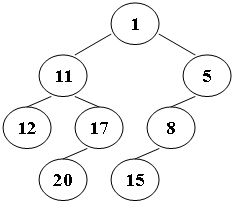Suppose that all the keys in a binary tree are distinct positive integers. A unique binary tree can be determined by a given pair of postorder and inorder traversal sequences. And it is a simple standard routine to print the numbers in level-order. However, if you think the problem is too simple, then you are too naive. This time you are supposed to print the numbers in "zigzagging order" -- that is, starting from the root, print the numbers level-by-level, alternating between left to right and right to left. For example, for the following tree you must output: 1 11 5 8 17 12 20 15.

Input Specification:
Each input file contains one test case. For each case, the first line gives a positive integer N (≤30), the total number of nodes in the binary tree. The second line gives the inorder sequence and the third line gives the postorder sequence. All the numbers in a line are separated by a space.
Output Specification:
For each test case, print the zigzagging sequence of the tree in a line. All the numbers in a line must be separated by exactly one space, and there must be no extra space at the end of the line.
Sample Input:
8
12 11 20 17 1 15 8 5
12 20 17 11 15 8 5 1Sample Output:
1 11 5 8 17 12 20 15题目大意:给定二叉树的后序遍历序列和中序遍历序列,然后输出ZigZagging序列????
ZigZagging这是什么玩意。。。
看Sample,大概知道了,是一种特殊的层序遍历,根节点正常输出,接着第一层正常层序,第二层要从右到左的输出,第三层正常,第四层又反过来。。。
这道题很有趣,解决方法是按照层,将每一层的正常层序序列存放到相应的容器中,然后隔一个一翻转就好了。
#include <iostream>
#include <algorithm>
#include <queue>
#include <vector>
#include <cstdio>
using namespace std;
const int maxn = 31;
int in[maxn], post[maxn];
vector<vector<int> > layer(maxn);
struct node{
int data, layer;
node *lchild, *rchild;
};
int find_in(int n){
for(int i = 0; i < maxn; i++)
if(in[i] == n)
return i;
}
node* Create(int postL, int postR, int inL, int inR){
if(postL > postR || inL > inR) return NULL;
node *root = new node;
root->data = post[postR];
int root_position = find_in(root->data),
lchild_length = root_position - inL;
int lchildPostL = postL,
lchildPostR = postL + lchild_length - 1,
lchildInL = inL,
lchildInR = root_position - 1;
root->lchild = Create(lchildPostL, lchildPostR, lchildInL, lchildInR);
int rchildPostL = lchildPostR + 1,
rchildPostR = postR - 1,
rchildInL = root_position + 1,
rchildInR = inR;
root->rchild = Create(rchildPostL, rchildPostR, rchildInL, rchildInR);
return root;
}
void BFS(node *root){
queue<node*> Q;
root->layer = 0;
Q.push(root);
while(!Q.empty()){
node *top = Q.front();
Q.pop();
layer[top->layer].push_back(top->data); //存放到层内
if(top->lchild){
top->lchild->layer = top->layer+1;
Q.push(top->lchild);
}
if(top->rchild){
top->rchild->layer = top->layer+1;
Q.push(top->rchild);
}
}
}
void fuck_layer(){
for(int i = 0; i < maxn; i++) //隔一层一反转
if(i % 2 == 0) reverse(layer[i].begin(), layer[i].end());
}
int main(){
int cnt;
cin >> cnt;
for(int i = 0; i < cnt; i++) cin >> in[i];
for(int i = 0; i < cnt; i++) cin >> post[i];
node* T = Create(0, cnt-1, 0, cnt-1); //建树
BFS(T); //层序遍历
fuck_layer(); //层序转ZigZagging
for(int i = 0; i < maxn; i++){ //打印每一层
for(int j = 0; j < layer[i].size(); j++){
if(i) cout << ' ';
cout << layer[i][j];
}
}
return 0;
}
